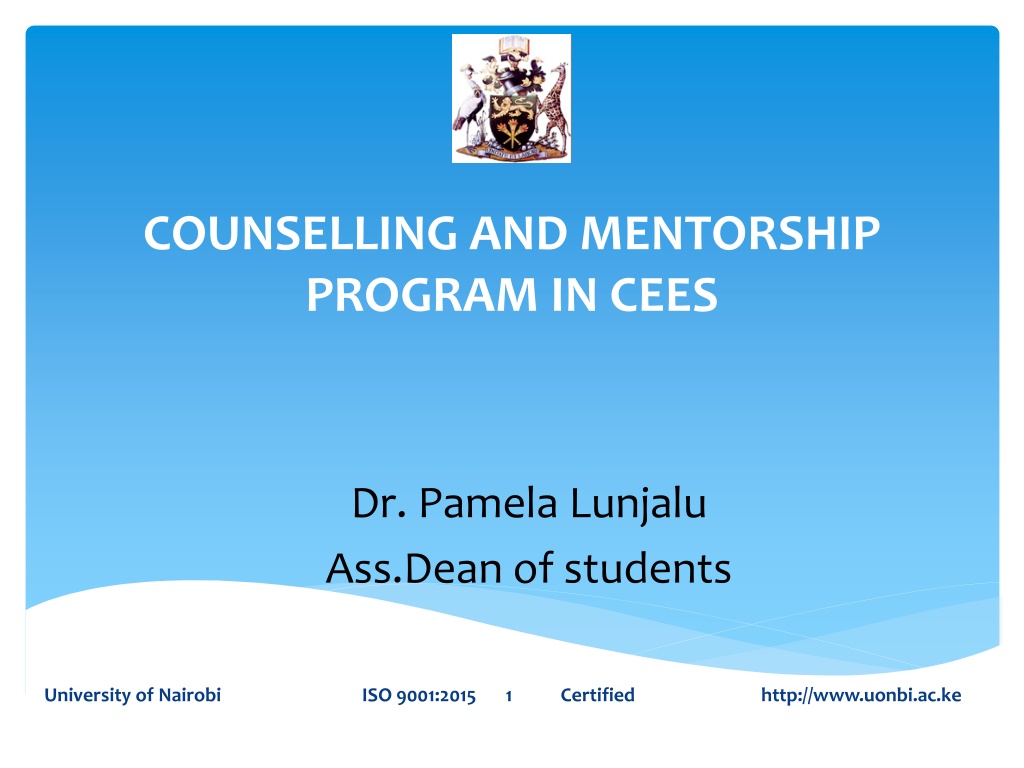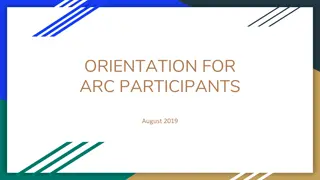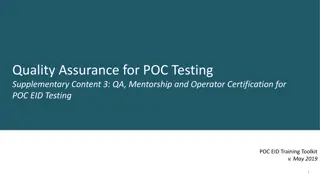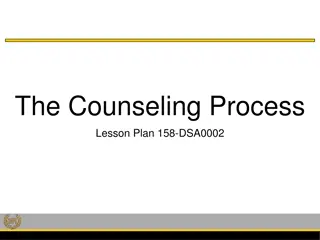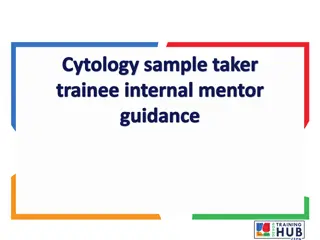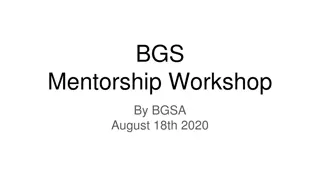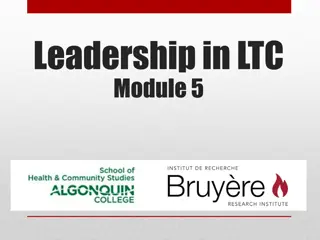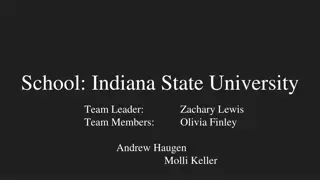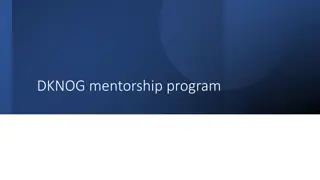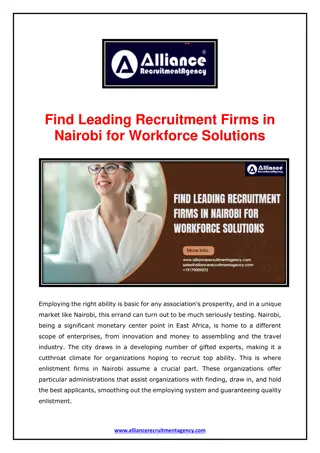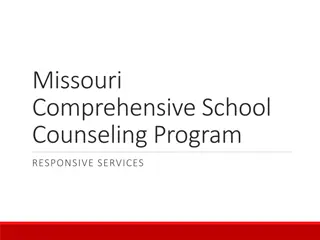Enhancing Student Support Through Counseling and Mentorship Program at CEES, University of Nairobi
The Counseling and Mentorship Program at CEES, University of Nairobi, led by Dr. Pamela Lunjalu, aims to provide structured support to students through individual counseling, group therapy, career guidance, and leadership skills training. The program follows ISO 9001:2015 standards, emphasizing continual improvement and quality management processes. Various activities, such as awareness campaigns on health issues and training student leaders, are conducted to promote student well-being and development.
Download Presentation

Please find below an Image/Link to download the presentation.
The content on the website is provided AS IS for your information and personal use only. It may not be sold, licensed, or shared on other websites without obtaining consent from the author. Download presentation by click this link. If you encounter any issues during the download, it is possible that the publisher has removed the file from their server.
E N D
Presentation Transcript
COUNSELLING AND MENTORSHIP PROGRAM IN CEES Dr. Pamela Lunjalu Ass.Dean of students University of Nairobi ISO 9001:2015 1 Certified http://www.uonbi.ac.ke
Background Prior to 1985, Counselling and Mentorship program in CEES was basically informal/unstructured and was mainly contacted by both the academic staff, non teaching staff and the University Health Services where the services were domiciled. In 1988, the university of Nairobi employed Assistant Dean of Students and Counsellors following establishment of the offices of the Assistant Dean of Students/ Counsellor and Placement Officer in 1985 whose tasks were not only to take care of the wellbeing of students but also to oversee counselling and mentorship programs at the college . In 2012 Ms Mumere was employed was employed as Assistant Dean and Student counsellor at CEES. Others who have served in the same capacity in include Emmy Sumbeiyo, Jane Kibicho, Susan Thuo, Jane Olago and currently Dr. Pamela Lunjalu. 2
Current Activities The counselling and mentorship activities undertaken at CEES are listed below. Individual/ one on one Counseling Group Therapy for those experiencing similar/related issues Planning and supervision of UNESA elections Sensitization and campaigns on Alcohol and Drug Abuse Sensitization and campaigns on HIVS/AIDS and Reproductive Health Making referrals to UHS For HIV/AIDS and Addiction Recovery Trainings for student leaders Recruitment, Training and supervising the work of Peer Counselors Orientation of new students on general wellbeing, integration, and adaptation Mentorship activities Career guidance and counseling Life Skills Training Leadership skills Financial management skills Report Writing Peer/Educators/counselors training Teaching practice skills 3
Features of ISO 9000 Standards Based on Eight Quality Management principles as the philosophy Consistent in terminology Emphasis on processes Employs QMS process model Embraces the spirit of Continual Improvement Allows for permissible Exclusions 4
Quality Management Process Model Continual improvement of the quality management system Management responsibility Customers Customers Resource management Measurement, analysis and improvement Satisfaction Output Input Requirements Product realization Product Product Key Value-adding activities Information flow 5
Spirit of Continual Improvement Goal: Goal: Attaining Higher levels Plan What to do? How to do? Act How to improve next time? Do Do what was planned Check Did things happen according to plan? Moving target QMS: Sustaining the gains 6
Benefits of Implementation of ISO 9001 To operate efficiently To achieve customer satisfaction To improve financial results Satisfy all the stakeholders To secure sustainability 7
The Principles The eight quality management principles: 1. Customer Focus 2. The role of Leadership 3. Involvement of People 4. Process Approach 5. System Approach to Management 6. Continual Improvement 7. Factual Approach to Decision Making 8. Mutual Beneficial Supplier Relationship 9
1. Customer Focus Organizations depend on their customers and therefore should understand current and future customer needs, should meet customer requirements and strive to exceed customer expectations Implication Customer focus means putting your energy into satisfying customers and understanding that profitability comes from satisfying customers. 10
2. Leadership Leaders establish unity of purpose and direction of the organization. They should create and maintain the internal environment in which people can become fully involved in achieving the organization s objectives Implication Leadership is providing role model behaviour consistent with the values of the organization. Behaviour that will deliver the organizations objectives. Internal environment includes the culture and climate, management style, shared trust, motivation and support 11
3. Involvement of People People at all levels are the essence of an organization and their involvement enables their abilities to be used for the organization s benefit Implication Involving people means sharing knowledge, encouraging and recognizing their contribution, utilizing their experience and operating with integrity 12
4. Process Approach A desired result is achieved more efficiently when activities and their related resources are managed as a process Implication Processes are dynamic-they cause things to happen. Processes within an organization should be structured in order to achieve a certain objective in the most efficient and effective manner 13
5. System Approach to Management Identifying, understanding and managing interrelated processes as a system organization s effectiveness achieving it s objectives contributes and to the in efficiency Implication Systems are constructed by connecting interrelated processes together to deliver the system objectives which in the case of the QMS is the satisfaction of the interested parties 14
6. Continual Improvement Continual improvement of the organization s overall performance should be a permanent objective of the organization Implication Continual improvement is the progressive improvement in organizational efficiency and effectiveness 15
7.Factual Approach to Decision Making Effective decisions are based on the analysis of data and information Implication Facts are obtained from observations performed by qualified people using qualified means of measurements i.e. the integrity of the the information is known 16
8. Mutual Beneficial Supplier Relationships An organization and it s suppliers are interdependent and a mutually beneficial relationship enhances the ability for both to create value Implication Beneficial relationships are those in which both parties share knowledge, vision, values, and understanding. Suppliers are not treated as adversaries 17
Outline of Requirements 1. Scope 2. Normative References 3. Terms And Definitions 4. Quality Management System 5. Management Responsibilities 6. Resource Management 7. Product Realization 8. Measurements, awareness And Improvement 19
1. Scope 1.1 general Requirements for demonstration of compliance to customer, statutory and regulatory requirements 1.2 Application provides requirements for exclusion of non applicable 20
4. Quality Management System 4.1: General Requirements 4.2: Documentation Requirements 4.2.1: Compulsory & Non Compulsory Documents 4.2.2 Quality Manual 4.2.3 Control of Documents 4.2.4 Control of Records 21
5. Management Responsibilities 5.1 5.2 5.3 5.4 5.5 5.6 Management Commitment Customer Focus Quality Policy Planning Responsibility, Authority & Communication Management Review 22
6. Resource Management 6.1 6.2 6.3 6.4 Provision of Resources Human Resources Infrastructure Work Environment 23
7. Product Realization 7.1 7.2 7.3 7.4 7.5 7.6 Planning Customer Related Processes Design and Development Purchasing Production and Service Provision Control of Monitoring and Measuring Devices 24
8.Measurement, Analysis and Improvement 8.1 8.2 General Monitoring Audits Control of non-Conforming Products Analysis of Data Improvement and Measurements-Internal Quality 8.3 8.4 8.5 25
Definitions: Internal Audit Systematic, independent and documented process for obtaining audit evidence and evaluating it objectively to determine the extent to which the audit criteria are fulfilled (ISO 19011 Clause 3.1) 27
Other Key Definitions -Auditing Definitions from ISO 19011:2002 3.2 3.3 Audit Criteria Audit Evidence Set of policies, procedures or requirements records, statements of fact or other information, which are relevant to the audit criteria and verifiable 3.4 Audit Findings results of the evaluation of the collected audit evidence against audit criteria 3.5 Audit Conclusions outcome of an audit, provided by the audit team after consideration of the audit objectives and all audit findings 28
Why do we have to Audit? ISO 9001:2015, clause 8.2.2 conducted to determine whether or not the management system: Conforms to the planned arrangement for each management system Is effective in meeting the organizations policy and objectives 29
Other Key Definitions -Auditing Audit Client 3.6 Auditor 3.8 organization or person requesting an audit Auditee 3.7 organization being audited person with the competence (3.14) to conduct an audit INVOICE KES-- 30
Other Key Definitions -Auditing 3.10 Technical expert 3.9 Audit Team one or more auditors (3.8) conducting an audit (3.1), supported if needed by technical experts (3.10) person who provides specific knowledge or expertise to the audit team (3.9) 31
The 3 Dimensions of Auditing Intent How does the organization intend to implement the QMS and how is this intent documented? Does the implementation of the QMS reflect the intent reflected in the design Is the system operating in an effective manner (i.e., does it meet the parameters established by the intent) Implementation Effectiveness
Principles of Auditing Ethical conduct Trust, integrity, confidentiality, discretion Fair presentation Audit findings and conclusions are accurate and truthful Due professional care Exercise care according to the confidence placed in them by clients independence Auditors are independent of the activities being audited and are free from bias or conflict of interest Conclusions will be objective and based only on audit evidence Evidence based approach Audit evidence is based on samples of information Conclusions are verifiable
Lead Auditor responsible for all phases of the audit have management capabilities & experience have authority to make final decisions regarding the conduct of the audit and audit observations co-ordinate the audit team and be able to represent the team & control the discussions be able to resolve conflicts within the audit team 34
Auditors They have a responsibility to: Adhere to procedures and plan the audit Collect and analyze relevant and sufficient evidence to permit drawing of conclusions have accurate knowledge of and be able to interpret and apply the underlying standards correctly (e.g. clause 7.1 on product realization) Remain within the scope & report stumbling blocks Make appropriate recommendations Be able to answer questions satisfactorily 35
Audit Scheduling The MR plans the audits The schedule must be comprehensive to ensure that each activity is examined at least once in a year.(freq dependent on Status of activity & importance of activity) In drawing an Audit Schedule, the audit area might be college, school, department t etc Selects auditors to ensure impartiality and objectivity 36
Pre-audit Meeting A meeting of the audit team to determine Objective/s Scope Criteria Assign responsibilities Resource requirements Audit plan 37
Establish Audit Purpose/Objectives Audit should be based on documented objectives as established within the overall objectives of the audit programme. For IQA mainly are: Determination of the extent of conformity of QMS to audit criteria Evaluation of effectiveness of QMS in meeting requirements Identification of areas of improvement 38
Audit Basis ISO 9001:2015 UON/QM (manual) UON/OP (procedures) Any statutory and regulatory requirements? 39
Audit Notification A standard format need to be used to contain as a minimum:- 1. Audit area/auditee 2. Audit purpose 3. Audit Scope 4. Audit basis 5. Date of audit 6. Audit team 7. Audit plan (timetable) 8. Resource requirements;-Guide, meeting room, special equipment, tools, etc 40
Audit Checklist Available in Q-Pulse Software 41
Four Phases of an Audit Opening meeting Execution of the audit Auditors meeting Closing meeting 42
Nonconformity Classifications Major nonconformity The absence of, or total systemic breakdown of a management system element specified in the standard or the QMS; any nonconformities where the effect is judged to be seriously detrimental to the organization; and any serious noncompliance to statutory/regulatory requirement Minor nonconformity A single system failure or lapse in conformance with a procedure relating to the standard or QMS
Raising Non Conformities Nonconformities should be: Recorded along with supporting evidence Reviewed with the auditee to ensure auditee understands and acknowledges findings: Auditor should resolve any diverging opinions Unresolved issues should be recorded classifying nonconformities, consider the seriousness: Major Non conformity Minor Non conformity 44
Raising Corrective Action On consultation with the auditor perhaps, and certainly those with people in the area where the nonconformity was found, the best corrective action can be decided The auditee has to get to the root cause of the problem if it is going to be corrected forever 45
Evaluating Corrective Actions The auditors must evaluate the proposed corrective action before acceptance; Definitions Corrections: action taken to eliminate detected non conformity Corrective actions: action taken to eliminate the source of detected non conformity Preventive actions: action taken to eliminate the source of a potential non conformity 46
Preparing the Audit Report A standard proforma for the reporting of audit is usually used Audit report should provide a complete accurate, concise and clear record of audit (audit objectives, scope, findings and conclusions) It is, therefore, important that the audit report gives a balanced picture of the whole audit (positive and negative findings) and not merely the nonconformities found 47
Preparing the Audit Report The audit report should include: Audit objectives and scope Identification of client, audit team leader and members Dates of audit Audit criteria Audit findings Summary of the non-conformities Positive findings noted Observations/Opportunities for improvement Examples of outstanding performance/improvement since last audit Audit conclusions Attachments (including copies of CARs) The audit report including any non-conformity report / corrective action notices are issued to the auditee & Management representative 48
Conducting Audit Follow-up The conclusions of the audit may indicate the need for corrective, preventive or improvement actions as applicable The auditee should undertake these actions within agreed timeframe The completion and effectiveness of corrective action should be verified by the auditor either onsite or through subsequent audits 49
